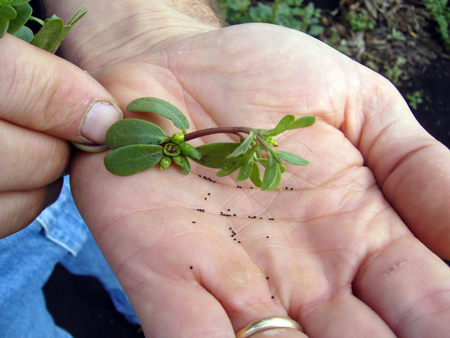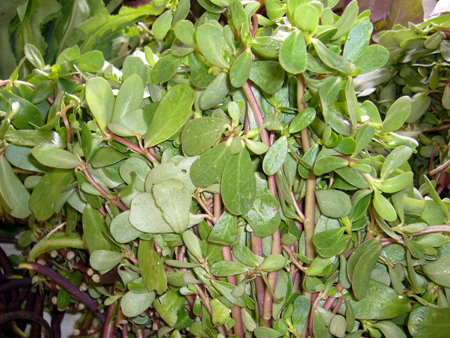Common purslane, weed it or reap?
Common weed may provide niche marketing opportunity for entrepreneurial growers.
Most growers and gardeners in the United States are familiar with a succulent, weedy and sometimes competitive plant known as purslane, pigweed, little hogweed, pusley or Verdolaga. The Latin name, Portulaca oleracea L., is the best identifier of this species, which is found worldwide. It has an extensive Old World distribution and its presence in North American dates back 500 years or more. It’s succulent nature enabling it to survive in drought, metabolic properties that mitigate stress, capacity to re-root from stem pieces after cultivation, and its tiny seeds that can survive in the soil for 40 years, gives growers reason to consider it a weed. One could regard the survival capacity of the seeds as a benefit, as this annual can reseed itself for repeat crops.
It is no accident that this adaptable plant has at least 44 ecotypes worldwide and has made itself at home in cool temperate, warm temperate, subtropic and tropical regions. However, this ancient species has not always been out of place; in fact the stems, leaves and flower buds are all edible and have been cultivated since ancient times for culinary and medicinal uses. Studies conducted at the University of Illinois in the 1970’s evaluated cultivated sources from California, Florida, France and India as representatives of improved cultivars that are more robust, have a more upright growth habit, and larger leaves. One can find varieties which are described as red, golden or green-leaved. However the “wild” purslane I have observed may also be an acceptable option for cultivation.
So in what cases should a grower consider adding purslane to their crop mix? Do you have customers for whom this is a traditional food? It is eaten throughout much of Europe, Asia and Mexico. Are your customers hearing about its high nutritive and antioxidant properties such as high levels of omego-3 fatty acids (alpha-linolenic acid, in particular), vitamins and antioxidants? Are your customers looking for something unique and different that may be eaten fresh as a salad, pickled, stir-fried, as a potherb, rolled in a tortilla or chopped in an omelet, soups or stews?
There have been University studies that show this weed to be non-competitive with many crops, even when forming a solid mat. In fact it may be beneficial as “living mulch” in certain crops such as sweet corn, beans and tomatoes. However, caution is advised because the abundance of long-lived seeds this plant produces may present problems in rotational crops. In addition there are no pesticides registered for edible purslane so it should not be harvested where organic or synthetic herbicides, insecticides or fungicides have been used. Be cautious about look-alikes that may not be edible and follow harvest and post harvest recommendations.
Works cited
Hopen, Herbert J., Spring, 1972, “Common Purslane-A Problem in Gardens and Horticultural Crops”, Illinois Research, University of Illinois Agricultural Experiment Station, Vol 14, No. 2
Hopen, Herbert J,.2010 Manuscript, “Common Purslane, a Vegetable That is Also a Weed”
Palaniswamy Usha, Department of Plant Science, University of Connecticut, “Purslane, a Power Food for the Future”. Hort Impact. 1998. Volume 98-1 p. 1-2.



 Print
Print Email
Email



